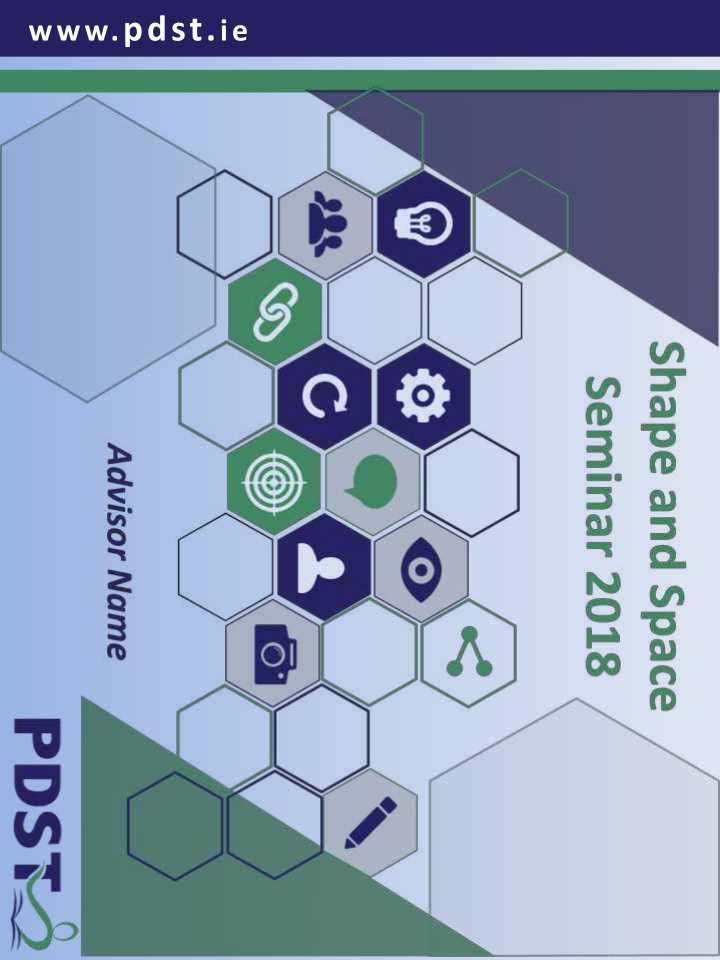



www. pdst. ie
Key Messages An inquiry based Classroom climate approach allows and choice of task pupils to engage can enable all pupils with STEM in real- to achieve success in Shape and Space. life contexts. The development of spatial reasoning is www. pdst. ie dependent on meaningful planning, teaching and assessment.
Rationale behind Shape and Space On average 8% of the 24 % of the curriculum content of textbooks objectives are shape pertains to shape and and space space 11% questions related Particular weakness in to shape and space on girls in relation to Sigma T 5 th /6 th class www. pdst. ie shape and space (9.3% Drumcondra)
Shape and Space Connections Geometry, spatial reasoning, and These core components are the foundations of measurement are topics that connect to each number lines, arrays in other and to other multiplication, fractions, mathematics, and that graphing, and topics connect mathematics to beyond. real-world situations. They also lie at the heart Therefore, across many of physics, chemistry, areas, we see that a www. pdst. ie biology, geology and picture/diagram/figure geography, art and can be “worth a architecture. thousand words.” (Adapted from: Fuson, Clements and Kazez, 2010; p57-63)
Gender and STEM “…brief educational interventions can “Many students have a stereotypically show marked improvements in the masculine image of mathematics and development of spatial ability in both science” genders” (Nosek, Banaji, & Greenwald, 2002; Smeding, 2012) (Uttal et al., 2013) “Educational interventions… counteracting the tendency for initially www. pdst. ie small sex differences in achievement to be translated into larger sex differences in career choices is likely to require concerted and sustained efforts…” (Reilly, Newman and Andrews, 2014)
Career Opportunities Surgeon Pilot Chef Astronomer Physicist Advertising Engineer Architect and Marketing Fashion Interior Designer Designer www. pdst. ie CNC Medical Builder Programmer Imaging Why teach Shape and Space?
How do pupils currently experience shape and space in your classroom? www. pdst. ie What are the successes and challenges? What are pupils’ prior or informal experiences?
Professional Reading www. pdst. ie
Odd One Out www. pdst. ie
Classroom Skills Climate Success www. pdst. ie
Square Corners On each of these grids the counters lie at the four corners of a square: What is the greatest number of counters you can place on the grid provided, without four of them lying at the corners of a square? www. pdst. ie Is it possible to predict the largest number of counters in any size grid? https://nrich.maths.org/1142
Classroom Skills Climate Success www. pdst. ie Knowledge is Mistakes are Struggle is shared Valued productive
Background Knowledge & Pupil Misconceptions ‘Pupils need to hear the language of position and have an opportunity to respond to the language before they can begin to use the language for themselves…unless pupils are www. pdst. ie given a real purpose for using the appropriate language, they are unlikely to make it a useful part of their vocabulary.’ (First Steps, p.23)
Background Knowledge & Pupil Misconceptions www. pdst. ie Background Knowledge & Pupil Misconceptions
What do you see? www. pdst. ie
Learning Trajectory Goal Clements and Sarama, 2013 Developmental Instructional Progression Activities Informal Deduction www. pdst. ie Van Hiele Model, 1957 Analysis Visualisation
How many nets of a cube can you find? www. pdst. ie
A Puzzling Cube Here are the six faces of a cube, in no particular order: Here are three views of the cube: www. pdst. ie Can you deduce where the faces are in relation to each other and record them on the net of the cube in your booklet? https://nrich.maths.org/1140
Continuum of Assessment -Concept Maps -Mind maps -Instructional -Tree Diagrams Framework -Minimal -Pupil Defining Lists Questioning -Work samples -Rubric -Maths Journal -Checklist -E portfolios -Target Child (Seesaw) -Time sample -Shadow study -Teacher/Child (Rubrics, portfolio) -Rubrics -Teacher/Teacher -Checklists -Teacher/Parent -KWL -Drumcondra -Two Stars & a Wish www. pdst. ie -Sigma T -PMI -Ballard Westwood -Rubric -Learning Log
Reflective Learning Logs Talk and discussion Open ended questions beforehand Writing should be in pupils’ own words but Pupils need to know incorporate appropriate their audience maths vocabulary www. pdst. ie Allow for a variation of Model the process and responses provide feedback
Developing and Assessing Skills Sorting Triangles (p.112) Pattern Block Symmetry (p.84) • Assessment Tool: Concept Mapping • Assessment Tool: Portfolio (Seesaw) www. pdst. ie Pentominoes (p.143) Constructing Triangles (p.160) • Assessment Tool: Conferencing • Assessment Tool: Self-Assessment
Spatial Skills and STEM “Science helps provide relevance to math that is all too often abstract and isolated calculation operations. (Johnson, 2011) “A child’s spatial skills level is a better predictor of STEM attainment than their maths skill level in 7 th grade.” www. pdst. ie (Wai, Lubinski & Benbow, 2009)
Spaghetti Structures Challenge: In groups, make the tallest, strongest tower using only spaghetti and marshmallows. www. pdst. ie
Linkage and Integration What learning Mathematical Skills outcomes could this lesson target? Implementing Shape and Space Understanding and Recalling Symmetry Science Skills Applying and Problem-Solving 2-D Shapes Working Scientifically Communicating and Expressing 3-D Shapes Questioning Integrating and Connecting Lines and Angles Observing Reasoning Spatial Predicting Awareness Investigating and experimenting Estimating and measuring Analysing: Sorting and classifying Recognising patterns Interpreting www. pdst. ie Mathematics Recording and communicating Spaghetti Number Designing and Making Exploring Algebra Structures Planning Making Shape and Space Evaluating Measures Data
An Integrated Approach to Skill Development Content Consider Skills Connections Prior knowledge Getting Started Misconceptions Challenges Working on the Mistakes www. pdst. ie Problem Successes Digging Self-reflection Deeper
Circle, Square, Triangle What is still going around in your head? What is squared away? www. pdst. ie What 3 activities will you use in your classroom?
Recommend
More recommend